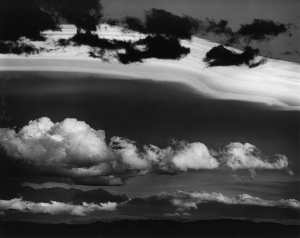
![]() One of the hallmarks of Brett Weston’s photographic style is the dramatic contrast between light and dark, evident even in his earliest work done in Mexico as a teenager. Nancy Newhall observed, “Already his love of intense blacks and whites is evident—black as space in which forms move, black as active force of repeating rhythm; white as pure continuous line, an accent—like a chisel cut or frost on darkness. Equally strong is his feeling for dynamics. Force and rhythm are as important to him as form.”[footnote]Quoted in Brett Weston Photographs from Five Decades (New York: Aperture, 1980), p. 57.[/footnote]
One of the hallmarks of Brett Weston’s photographic style is the dramatic contrast between light and dark, evident even in his earliest work done in Mexico as a teenager. Nancy Newhall observed, “Already his love of intense blacks and whites is evident—black as space in which forms move, black as active force of repeating rhythm; white as pure continuous line, an accent—like a chisel cut or frost on darkness. Equally strong is his feeling for dynamics. Force and rhythm are as important to him as form.”[footnote]Quoted in Brett Weston Photographs from Five Decades (New York: Aperture, 1980), p. 57.[/footnote]
Newhall’s observations are especially applicable to Untitled (Desert Clouds), where the details of landscape give way to the dynamic shapes of clouds.[footnote] This photograph is titled Untitled (Desert Clouds) on the recommendation of the Brett Weston Archive. Weston did not assign specific titles to individual photographs, but chose to use descriptive titles referring to subject or location. Since this photograph has been published under various titles, experts at the Archive suggest using this convention.[/footnote] While the exact location of this photograph is not known, clearly considerations of the sky outweighed those of the land below for the artist. Unlike Ansel Adams, whose zone system was designed to preserve details in deep shadows and highlights, Weston did not hesitate to allow undifferentiated dark forms to act as shapes in his photographs.
At this point in his career, Weston was using a variety of large and medium format cameras, including a Mamiya RB 67, a 6 x 7 medium format camera first released in 1970, and a Rollei SL 66, whose square format negatives Weston had no qualms about cropping to a rectangular format.